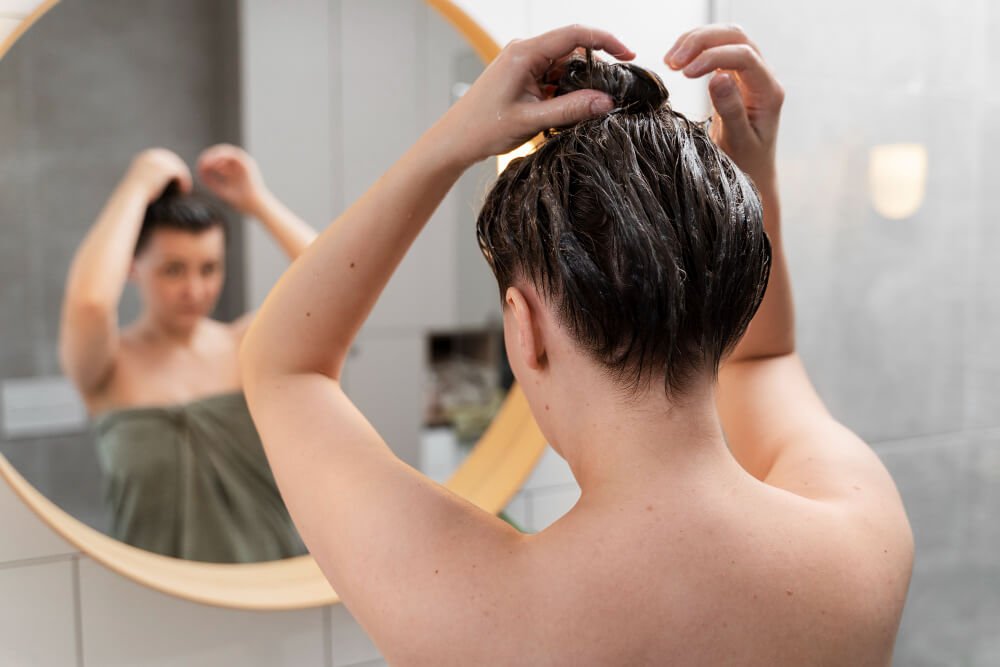Hair masks are powerful tools in any hair care routine—but only if used correctly. From choosing the right formula to applying it the right way, there are a few key things every woman should know.
Misusing a hair mask can leave your strands greasy, weighed down, or even more damaged. This guide breaks down the most common hair mask mistakes and shows you how to get silky, healthy hair without setbacks.
Table of Contents
Why Hair Masks Are Worth It—If You Use Them Right
Hair masks are not just a luxury. They’re a deep-conditioning treatment designed to repair damage, restore moisture, and protect your strands from everyday stress.
But despite their benefits, many women unknowingly make small mistakes that cancel out all the good they’re trying to do.
The Natural Oil That Finally Helped My Hair Breathe Again – See How It Removes Years of Residue!
Maybe you’ve applied a mask expecting smooth, luscious locks—only to end up with greasy, flat hair that feels heavy. Sound familiar? Don’t worry. We’ll show you exactly how to avoid those frustrating results.
Applying Too Much Product: More Is Not Always Better
Overloading your hair with product can leave it heavy and greasy, especially if you already have fine or oily hair. Masks are designed to be potent, so a little goes a long way.
- Use a quarter-sized amount for short to medium hair.
- If you have long or thick hair, adjust—but don’t overdo it.
- Always start with less and build up if needed.
It’s better to apply a small amount evenly than to drench your hair and risk an oily mess.
I Thought My Hair Had Stopped Growing… Until This Natural Detox Oil Changed Everything – Click to Learn More!
Don’t Apply Hair Masks on the Scalp Unless It’s Meant for That
The scalp produces its own oils and doesn’t usually need extra moisture. When you apply a heavy, oil-rich mask to your roots, you risk clogging pores, causing itchiness, or leaving your hair looking unwashed.
Instead, focus your mask on the mid-lengths to the ends, where your hair is older and more prone to dryness and damage.
Tip: Always read the label. If a mask is scalp-safe, it will say so.
Clean Hair Matters: Always Shampoo First
Hair masks need a clean surface to work their magic. If your strands are full of buildup, sweat, or oil, the nutrients in the mask won’t penetrate properly.
Here’s the right order:
- Shampoo first to remove dirt and oil.
- Gently towel-dry so the mask isn’t diluted by too much water.
- Apply the mask, leave it in, then rinse thoroughly.
This small shift in your routine can boost your mask’s benefits tenfold.
Timing Is Everything: Don’t Leave It On Too Long (or Too Little)
Most masks are designed to work within 5–15 minutes. Any less, and the nutrients haven’t soaked in. Any longer, and you might cause buildup or scalp irritation—especially if it’s a protein-rich formula.
Set a timer if needed, and always follow the product instructions. If you want deeper results, try covering your hair with a warm towel while the mask sits.
Using the Wrong Mask for Your Hair Type
Using a hydrating mask on already oily hair can weigh it down. Using a protein-rich mask on dry, brittle hair can make it even stiffer. It’s all about knowing your hair’s needs and picking a product that’s made to match.
Common hair concerns and ideal mask types:
- Dry or damaged hair → Go for moisturizing or repairing masks with oils and butters.
- Color-treated hair → Use color-protecting masks with antioxidants.
- Fine hair → Choose lightweight, volumizing masks that won’t flatten strands.
- Frizzy hair → Look for smoothing masks with ingredients like keratin or silk protein.
Still Fighting Frizz and Breakage? This 100% Natural Oil Targets Hidden Chemical Residue – Click Here to See the Proof!
Don’t Overdo It: Hair Masks Are Not for Daily Use
Once or twice a week is usually enough—even for dry or damaged hair. If you’re masking daily, you could be over-conditioning your hair, making it limp and unmanageable.
Instead of masking every day, try alternating with a lightweight conditioner and give your hair some breathing room.
Distribute the Mask Evenly for Balanced Results
Uneven application means some sections get all the nutrients, while others are left out. For best results:
- Section your hair into manageable parts.
- Apply the mask from the mid-lengths to the ends.
- Use a wide-tooth comb or your fingers to distribute it evenly.
This small step makes a big difference, especially for those with thick or curly hair.
Rinse Thoroughly to Avoid Buildup
Leaving traces of product behind can make your hair feel sticky or coated. It can also cause buildup over time, which dulls your shine.
Use lukewarm water to rinse out the mask completely. If your hair feels slippery or coated, keep going until it feels fresh and clean.
Conclusion: The Secret to Hair Mask Success Is in the Details
Hair masks are powerful allies in your hair care arsenal—but only when used the right way. By avoiding the common mistakes women make when using hair masks, you’ll start seeing real results: softer, shinier, stronger hair with every use.
So here’s what to remember:
- Don’t overdo it—less is more.
- Keep it off your scalp unless it says otherwise.
- Always shampoo first and rinse thoroughly.
- Choose the right mask for your hair type.
Treat your hair with intention, and your mask will return the favor.

